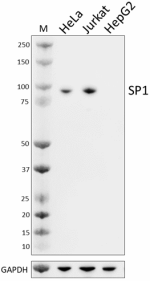- Clone
- W21043E (See other available formats)
- Regulatory Status
- RUO
- Other Names
- Transcription factor sp1, TSFP1, Specificity Protein 1
- Isotype
- Rat IgG2a, κ
- Ave. Rating
- Submit a Review
- Product Citations
- publications

-

Whole cell extracts (15 µg total protein) from the indicated cell lines were resolved on a 4-12% Bis-Tris gel, transferred to a PVDF membrane, and probed with 1.0 µg/mL of purified anti-SP1 (clone W21043E) overnight at 4°C. Proteins were visualized by chemiluminescence detection using HRP goat anti-rat IgG (Cat. No. 405405) at a 1:3000 dilution. Direct-Blot™ HRP anti-GAPDH (Cat. No. 607904) was used as a loading control at a 1:50000 dilution. Western-Ready™ ECL Substrate Premium Kit (Cat. No. 426319) was used as a detection agent. Lane M: Molecular weight marker -

HeLa cells were fixed with Fixation Buffer (Cat. No. 420801) for 10 minutes and permeabilized with 0.5% Triton X-100 for 10 minutes, and blocked with 5% FBS for 1 hour at room temperature. Cells were then stained with 1.25 µg/mL of either purified anti-SP1 (clone W21043E) (panel B) or purified rat IgG2a, κ isotype control (Cat. No. 400502) (panel A) followed by incubation with Alexa Fluor® 594 goat anti-rat IgG (Cat. No. 405422) for 1 hour at room temperature. Nuclei were counterstained with DAPI (Cat. No. 422801). Images were captured with a 60X oil objective. Scale bar: 50 µm -

IHC staining using purified anti-SP1 (clone W21043E) on formalin-fixed paraffin-embedded human skin tissue. Following antigen retrieval using Tris-EDTA buffer (10 mM Tris, 1 mM EDTA, pH 9.0), the tissue was incubated without (panel A) or with (panel B) 1.0 µg/mL of purified anti-SP1 (clone W21043E) overnight at 4°C, followed by incubation with 2.5 µg/mL of Alexa Fluor® 647 goat anti-rat IgG (Cat. No. 405416) for one hour at room temperature. Nuclei were counterstained with DAPI (Cat. No. 422801). The image was captured with 40X objective. Scale bar: 50 µm
| Cat # | Size | Price | Quantity Check Availability | Save | ||
|---|---|---|---|---|---|---|
| 615251 | 25 µg | 156€ | ||||
| 615252 | 100 µg | 387€ | ||||
SP1 belongs to the transcription factor SP/KLF family, which contains three zinc finger domains that can bind to GC boxes and regulate transcription of a variety of molecules. SP1 regulates efferent gene transcription positively and negatively, participating broadly in cellular development and physiological functions as a generally expressed transcription factor. Post-translational modifications, including phosphorylation, glycosylation, acetylation, ubiquitylation, and SUMOylation, highly regulate SP1’s function and stability. SP1 is required to develop and differentiate early embryo, placenta, and sperm cells. SP1 is highly expressed in multiple cancers including breast, stomach, pancreas, lung, and brain. SP1 promotes tumor cell proliferation, inactivates cell death, and facilitates immune escape.
Product DetailsProduct Details
- Verified Reactivity
- Human, Mouse
- Antibody Type
- Monoclonal
- Host Species
- Rat
- Immunogen
- E. coli derived recombinant fragment of human SP1
- Formulation
- Phosphate-buffered solution, pH 7.2, containing 0.09% sodium azide
- Preparation
- The antibody was purified by affinity chromatography.
- Concentration
- 0.5 mg/mL
- Storage & Handling
- The antibody solution should be stored undiluted between 2°C and 8°C.
- Application
-
WB - Quality tested
ICC, IHC-P - Verified - Recommended Usage
-
Each lot of this antibody is quality control tested by western blotting. For western blotting, the suggested use of this reagent is 0.25 - 1.0 µg/mL. For immunocytochemistry, a concentration range of 1.25 - 5.0 μg/mL is recommended. For immunohistochemistry on formalin-fixed paraffin-embedded tissue sections, a concentration range of 1.0 - 10.0 µg/mL is suggested. It is recommended that the reagent be titrated for optimal performance for each application.
- Application Notes
-
The mouse cross-reactivity of this product has been verified by WB.
For use in immunohistochemistry (IHC), antigen retrieval with Tris-EDTA pH 9.0 is recommended.
For use in immunocytochemistry (ICC), paraformaldehyde fixation is recommended. - RRID
-
AB_3083401 (BioLegend Cat. No. 615251)
AB_3083401 (BioLegend Cat. No. 615252)
Antigen Details
- Structure
- SP1 is a 785 amino acid protein with an expected molecular weight of about 80.6 kD.
- Distribution
-
Nuclear/Ubiquitous
- Function
- Binds to GC boxes to regulate transcriptional activity
- Interaction
- EP300, E2F1, RELA, HDACs, SMADs, BRCA1, BRCA2, RNF4, c-MYC, c-JUN, p53
- Biology Area
- Angiogenesis, Apoptosis/Tumor Suppressors/Cell Death, Cell Biology, Cell Cycle/DNA Replication, Cell Death, Cell Proliferation and Viability, Chromatin Remodeling/Epigenetics, DNA Repair/Replication, Immunology, Neurodegeneration, Signal Transduction, Transcription Factors
- Molecular Family
- Nuclear Markers
- Antigen References
-
- Saffer JD, et al. 1991. Mol Cell Biol. 11:2189-99.
- Thomas K, et al. 2007. Mol Cell Endocrinol. 270:1-7.
- Vizaino C, et al. 2015. Pharmacol Ther. 152:111-24.
- Beishline K, et al. 2015. FEBS J. 282:224-58.
- Gene ID
- 6667 View all products for this Gene ID
- UniProt
- View information about SP1 on UniProt.org
Related FAQs
Other Formats
View All SP1 Reagents Request Custom Conjugation| Description | Clone | Applications |
|---|---|---|
| Purified anti-SP1 | W21043E | WB,IHC-P,ICC |
Compare Data Across All Formats
This data display is provided for general comparisons between formats.
Your actual data may vary due to variations in samples, target cells, instruments and their settings, staining conditions, and other factors.
If you need assistance with selecting the best format contact our expert technical support team.
 Login / Register
Login / Register 










Follow Us